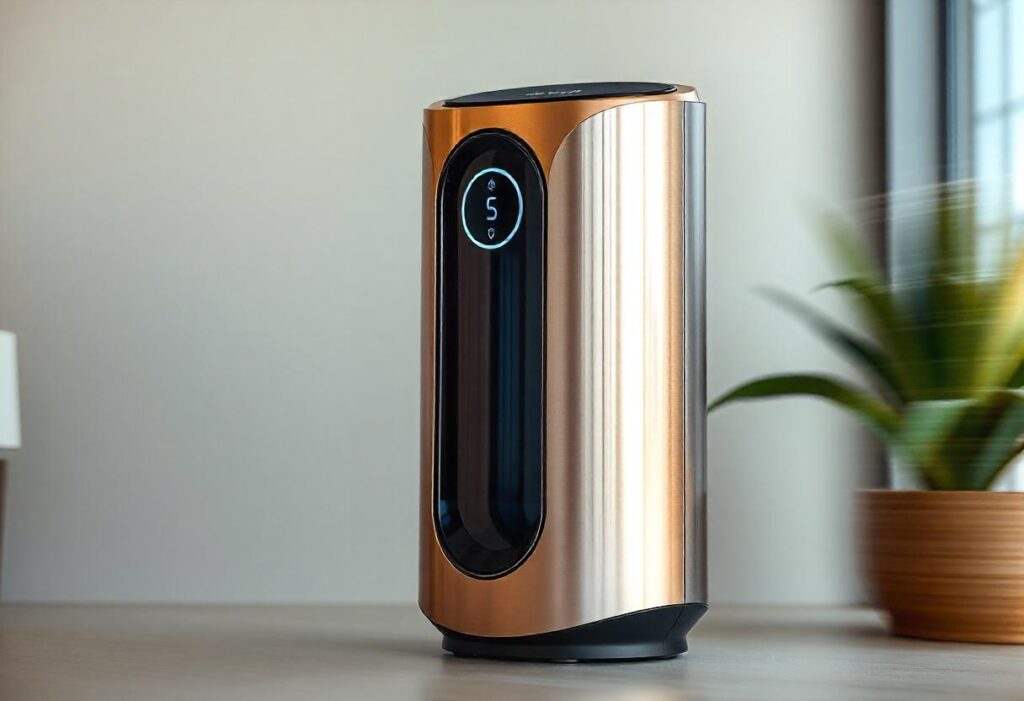As an experienced heating technician, I’ve seen it all, from the simplest little electric space heaters to some pretty complex central heating units. Fan heaters are also an ideal space-saving heater, taking up less room than traditional units. The following guide provides an overview of how these heaters operate, their energy usage, installation and maintenance considerations, and safety features. As a homeowner or someone examining heating solutions, orienting on these heaters from the mechanical standpoint will allow you to make strategic choices at the end of the day.
What Is a Fan-Forced Heater?
A fan-forced heater, also known as a “blower heater”, is a type of convection heater (a heater that uses air to transport heat) that works by blowing air over a heated surface. This model provides faster heat circulation compared to convection heaters.
Critical elements of the fan-forced heater include a heating element consisting, either metal coils that are heated rapidly which convert electrical energy into heat or of durable ceramic plates to generate heat speedily; A motor for the fan activates fan blades to propel air across the heating element distributing warm air throughout your room and Thirdly a thermostat which monitors temperature by turning on material inside, in short heats up and cools down.
Safety features such as overheat protection sensors, tip-over shut-off switches, and flame-retardant housings increase safety. Housings and grilles (usually of heat-resistant plastic or metal) serve to protect persons from coming into contact with hot surfaces.
How Does a Fan Forced Heater Work?
A fan-forced heater operates on the same forced convection principle, but it more directly takes up a position in a room so that air movement is provided by the device’s tilting back and forth. When on, a built-in fan draws ambient air over the heated element (commonly made by heating on nichrome wire or stainless steel) or a ceramic block. This heats the air quickly, then blows it out into the room through a fan. The warm air flow of this product, also known as “Moist Heat,” imparts a comfortable feeling of warmth that has an almost immediate effect in the area being heated. The process is controlled by a built-in thermostat that cycles the heater on and off to maintain the set temperature.
Fan-forced heating works by convection, where a fan is used to distribute heated air throughout the working space. When the switch is on, electricity flows to the heat element (a metal or ceramic coil). Fresh air is pulled into the heater from the room through vented doors. The built-in fan blows air over the heated element and increases the air temperature quickly. This warm air is then routed through the front-facing grill of the heater, generating and projecting an even amount of heat. The built-in thermostat automatically cycles the heater on and off to maintain optimal temperature. Its active heating system also makes it perfect for rapidly and efficiently warming small to medium-sized rooms.
Are Fan Forced Heaters Safe?
However, when used properly, fan-forced heaters can be remarkably safe, as they contain many inherent safety features that mitigate risks. Today’s devices have built-in overheat protection sensors that automatically shut down the device when it becomes too warm. Furthermore, tip-over shut-off switches will stop your room heater in the event it is inadvertently knocked over. Some heaters are also designed with a cool-touch exterior and a flame-resistant housing, which helps prevent burns and reduces the risk of fire. Most importantly, it’s essential to always plug the heater directly into a wall outlet and keep it at a distance of at least three feet from flammable items.
Heating Capacity and Energy Efficiency of Fan-Forced Heaters
The power is normally specified in watts (W) or British thermal units (BTU). Most household models fall between 750W and 1,500W (or roughly 2,500 to 5,100 BTUs) — enough heat for a small- or medium-sized room measuring up to about 150 square feet. Variable Heat Settings – Most models come with a low and high heat setting, typically around 750W/1,500W, allowing you to adjust the temperature level easily.
Fan heaters can convert electricity into heat with nearly 100% efficiency, but their effectiveness depends on the room insulation, size, and use. Heaters with programmable thermostats can help prevent energy waste, as they maintain steady temperatures. Some high-quality models also feature eco-modes that conserve power when the room reaches its ideal, cozy temperature. The formula to find cost per hour is: Cost per Hour = ( Heater Wattage ÷ 1,000 ) × Electricity Rate. A 1,500W heater operating for one hour at $0.20/kWh costs approximately $0.30/hour, resulting in a charge of around $54/month when operated frequently.
Lifespan and Noise Level of Fan-Forced Heaters
If you look after it, you can expect 5–10 years of service from a fan-forced heater. Length of Life – ceramic heater models last longer because the materials are durable, not as susceptible to wear (metal coil models may break down faster due to oxidation).
Practically, fan-forced heaters produce some noise, which may range from 40–60 decibels (dB) sound levels—a level matching that of a quiet conversation or background music. For a quieter bedroom or office, you can get low-noise models.
Advantages and Disadvantages of a Fan-Forced Heater
Fan-forced heaters provide quick heating, they are small and portable, feature thermostatic control for consistent room temperature, and are generally relatively cheap. However, they generate noise, which is disturbing in quiet environments, are not cost-effective for large halls, and they even spread dust due to sensible airflow.
Installation and Safety Tips for Fan-Forced Heaters
Good positioning is key; mount the unit on a flat and stable surface, well out of the way from flammables with at least 3 feet of clearance. Ensure the heater is plugged directly into a wall outlet to prevent overheating due to extension cords. Wall-mounted units have been designed with correct mounting brackets. Consult an electrician to mount or hardwire the unit if necessary.
You can use the heater in a dry space and avoid wet places, unless the model specifically indicates it is suitable for such use. Frequently check for frayed cords and obstructed vents. Opt for models with automatic overheat protection and tip-over switches, and unplug the device while it’s not in operation to minimize electrical risks.
Fan Forced Heater Maintenance Tips
By following these steps, you can perform regular maintenance that will help your fan-forced heater function properly and last many years. The most critical action is to ensure that the air intake vents and fan blades in your firebox are cleaned regularly and are free from dust clogs or debris that can cause restricted airflow, leading to overheating of the unit. Blowing out the dust (ahead of blowing air all over the machine) with compressed air is reasonable. You’ll also want to examine that power cord for any frays or issues, and look at the heating element for discoloration as a sign of wear. The fan motor may require lubrication for silent operation. It is easy to do and will keep your heater operating smoothly and safely.
Fan Heater Running Costs Australia
In Australia, the running cost of a fan-forced heater will be determined by wattage and your electricity rate. For example, if you have a 1,500W heater on high setting, it will consume 1.5 kilowatt-hours (kWh) of electricity after running for one hour.
To estimate the cost, multiply this consumption by your electricity rate, which can vary significantly among states and providers. For instance, an electric 1,500W heater at the current national average of $0.30/kWh will cost around $2.70 per day to run for 6 hours or about $81/month.
These heaters, which are nearly 100% efficient at converting electricity to heat — the laws of physics prohibit anything from being 100% efficient — can quickly run up your power bill if used to warm very large, poorly insulated spaces.
Fan-Forced Heaters: Your Top Questions Answered
Fan-forced heaters will also generate a moderate level of noise during operation, between 40 and 60 dB. This is akin to the noise level of a subdued or muted conversation. To cater to users who work in quiet environments, such as bedrooms or offices, we have introduced low-noise models specifically designed to produce less noise.
Yes, fan-forced heaters can be high-wattage devices, and their energy usage does accrue, particularly over extended periods of time. Most 1,500W heaters consume 1.5 kilowatt-hours (kWh) of electricity every hour.
To keep costs down, it is generally advisable to use them for spot heating, rather than as a primary heat source throughout an entire home. Models with programmable thermostats and eco-modes can also cut down on energy waste.
You cannot normally use an ordinary fan-forced heater in a bathroom unless the heater is mentioned as being approved for damp sites. The bathroom is a mainly humid environment, and water and electricity don’t mix well.
For a bath in your family bathroom, ensure you use a heater such as the IXL Tastic, which has been specifically designed and safety-rated, with an IP (Ingress Protection) rating to prevent water contact.
If your fan-forced heater is blowing cold air, you should first check that the heater is correctly plugged in and that the thermostat on it is set to a temperature higher than the current room temperature. The overheat protection sensor has tripped, turning off the heater.
If not, do so and wait for the unit to cool down and reset itself. If it is not, there may be a heating element problem that requires servicing or replacement.
Final Thoughts
Fan-forced heaters provide quick and efficient heating in medium- and small-sized rooms. Understanding how they work, monitoring power usage, and maintaining them regularly will help keep your lights burning longer and brighter. It’s better to be safe and smart for a cozy, warm house.

